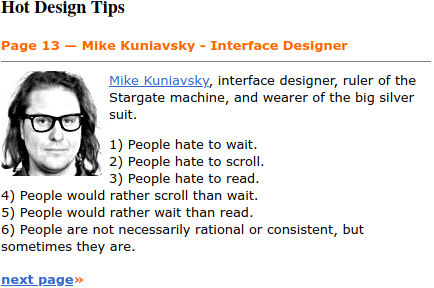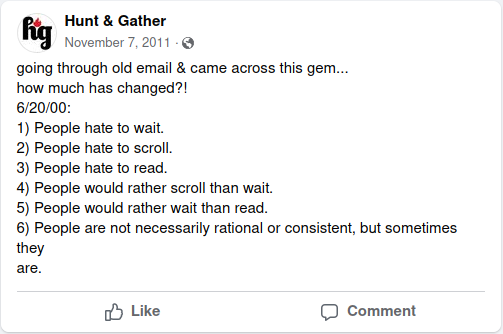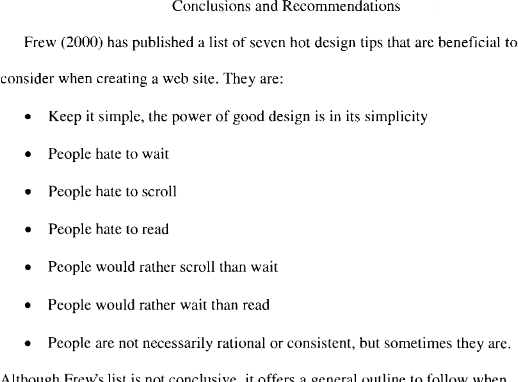Hot Web Design Tips Circa 1998
People hate to wait
In my youth I was a hobbyist web developer. Ok, I’ll admit the term “developer” is a stretch, but when I wasn’t actively noodling in text editors writing HTML and in Photoshop making “cool” graphics, I was soaking up every bit of design and web know-how the early web could provide. Just as my first web pages have been lost to time, web design advice from the early 2000s isn’t exactly fresh. Time marches on. Yet one set of design principles I read during that time really stuck with me.
Originally posted on Webmonkey.com in 1998, I’ve reproduced the list below. Credit to Mike Kuniavsky1
- People hate to wait.
- People hate to scroll.
- People hate to read.
- People would rather scroll than wait.
- People would rather wait than read.
- People are not necessarily rational or consistent, but sometimes they are.
These are more interface design principles rather than web design principles, but I think that’s why they work as well as they do today. Sure, the internet of today is quite a different place (thanks, infinite scrolling), but human beings are essentially the same now as they were were 20, 200, or 2000 years ago.2 People expect responsiveness, people don’t always behave like you’d expect, unless they do. The list still feels right. And when this list was originally posted, the web was very much the wild west; land as far as the eye could see, and the only rules were what you applied yourself, and everyone was fresh off the train from back east. The early web style and “usability” reflected that environment. What I like about the advice is that on the surface it appears to denigrate the typical web user, and yet by framing these as interface design principles it puts the needs of the user front and center.
I’m sure I’ll speak more on this in the future, but the modern web also feels user hostile, with autoplaying ads, pop-ups and the like. If not predatory auto-generated SEO bait ad-traps, then slick skinner boxes leveraging user-generated content to groom the next generation of content consumers. Blech.
People hate to scroll
But this post isn’t about any of that. Earlier I said the principles above stuck with me, but that’s not entirely true. What stuck with me was the gist of the principles. I remembered something about people hating things (waiting? scrolling?) I never remembered which things people preferred to other things. I completely forgot there was a sixth principle, which is a shame because it really serves as a perfect punchline. I never remembered the details, much less who wrote it or where I read it. It was just one of those things that the internet seemed to spontaneously generate in those days.
The clever amongst you will see the problem: if I couldn’t remember the rules, how did I reproduce them above? I’ve intentionally started this post at the end of the story, but for the beginning of the story we must go back about six months ago.
People hate to read
About six months ago,3 I suddenly found it absolutely necessary I answer the question “Where on earth had I learned that hot design tip, and what exactly was it?” Long story short, after about an hour of googling I found the original article Hot Design Tips from one of the premier web development sites of the 2000s, Webmonkey.com. Webmonkey.com was mothballed several different times in the mid 2000s, until years ago acquired and eventually retired by Wired, but through the power of the Wayback Machine and screenshotting, I can share it below.

To tell the truth, I expected it would take longer to find. Even so, the path I took was not direct from search engine to result, and I found it interesting. At the time I thought to myself, “One day this will make a pretty ok blog post.” Fast forward to last weekend when I thought to myself, “Today this will make a pretty ok blog post.”
People would rather scroll that wait
Last weekend as I finally sat down to pen my grand adventure, I could find no record of what I had done. There were no notes, no text file or word document, no internet bookmarks or search history. I wasn’t even able to remember which of my computers I had been using when I did the research.4 I don’t know what past Guy was thinking, but he certainly wasn’t doing more recently past Guy any favors. Sitting down to write, I felt like that person trying to tell you about an incredible movie they’d seen years ago, but only really remembering how they felt about it, so they waffle on for what seems like hours and you still wouldn’t be able to name a main character or even the rudiments of story arc.5
The frustrating part was that I wasn’t really interested in writing about the rules themselves, the rules were a pretense to share the journey. But I had no journey, I only had the destination. I wasn’t about to do the easy thing of just hoisting up the list and calling it a day. No indeed, I was going to re-create the journey, and then write about that.6
People would rather wait than read
I knew the advice was a list, starting with “People hate to wait” but also containing “People hate to read” and “People hate to scroll”, but then also listing relationships between the states, (e.g. “People would rather X than Y”). But people hate to wait in lots of contexts, and people hate to read in almost every context. Trying to search for these terms was completely fruitless. My first attempts were essentially brute forces of various combinations of what I remembered of the list, until I hit the first big break: a post from November 7, 2011 from the Hunt & Gather facebook group.

This was it! This was the advice I was looking for. I now had all the nuance of the original (assuming the quotation was accurate), and better yet, I also knew it was from no later than June 20, 2000.7 Armed with the phrase “People would rather scroll than wait,” I was lead to a graduate research paper published in 2001 about web page design. Relevant excerpt from the paper is reproduced below.

Thank the Lord for academia, I was able to get the original Webmonkey.com article URL from the citation. As soon as I saw Webmonkey, I knew I had gotten the right place. A site that I had nearly forgotten, suddenly rushed back to my mind. The web address citation was a little garbled from whatever OCR they used when scanning the paper (see below) but the hunt was essentially over.

I tooled around in the Wayback Machine to find the earliest version of the article and the specific set of tips, and Bob, as they say, was my uncle.8
People are not necessarily rational or consistent, but sometimes they are
The original Webmonkey article was so much more interesting to find than I expected. As I could only ever remember the tips I’ve already shared here, I was thrilled to find so many more 2000s era web design tips in one place. Some are timeless (“You have three seconds to convince a user not to use the Back button.”) and others are hopelessly outdated (“Learn Flash. Now.”). Some are painfully relevant (“Remember it always takes twice as long as you think it’s going to”) and others I’ve already broken in this post (“Never, ever put a word in a graphic.”). As I noted earlier, it’s the user interface and user experience tips that seem to be the most relevant today. It brings to mind something I read in the design considerations graduate paper I found, where back in 1968 studies showed people expected response times to be less than one second for interactive content.9
But more than all that, one of the main purposes of www.guyinterlinked.com is to explore the ethos of the early web. I’m looking forward to mining the article for tips as I create a fusion of 2000s aesthetic and modern technologies.
And oh, always add a bit of acid green. - Barbara Kuhr
Further Reading
- Hot Design Tips The original Webmonkey.com article.
- Archived here someone in 2001 took all the tips from the Webmonkey article and jammed them into one Geocities page.
- Whatever Happened to Webmonkey.com?
- Staker, Damon, “Fundamental Design Considerations For Creating Web Pages” (2001).Graduate Research Papers. 1580.
- UXMyths.com - Myth #3: People Don’t Scroll
- Hunt & Gather
Footnotes
-
As a matter of principal, I’ve linked to a Mr. Kuniavsky’s public notebook that hasn’t been updated in 10 years. Nothing personal, Mike. ↩
-
Like the classic joke, Selena Gomez, Walt Whitman and Pliney the Elder are scrolling on instagram when… ↩
-
This attempt isn’t the first time I’d tried to find the source of the rules. Several years ago I got what I thought was close, a longer form blog post that had many of the elements, but it was, well, a blog post. Maybe one day I’ll try to find that article. ↩
-
To give you an indication of the complexity of my life, I own three personal computers, among which are four operating systems and seven web browsers, all of which I use for some reason. This may make a pretty ok blog post one day. ↩
-
The cinematography was incredible, even though when pressed they would not be able to describe a single shot. It was a great movie. You should see it. It’s called… uh… ↩
-
I am glad it finally worked out, because I’m not sure I would be thrilled to write about how I almost re-traveled a mildly interesting internet rabbit hole I went down six months ago. (He says, as if you’d be thrilled to read it.) ↩
-
I liked how the Hunt & Gather post credited the quote from an email, again as if the rules were cast forth from the internet itself. ↩
-
If they do say it, they never say it that way. ↩
-
So Leonard Nimoy was scrolling on instagram when… ↩